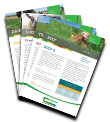
Dairy Newsletter – January 2023
Dairy Newsletter – January 2023 23 January 2023 Type Newsletter Download Publication (PDF) In this month’s edition: Managing early N this springHigh fertiliser nitrogen (N) prices significantly increased cash costs on dairy farms in 2022 and will continue to do so this spring. However, a lack of N supply in the soil limits spring grass […]
23 January 2023
Type Newsletter
By

Dairy Newsletter – January 2023
23 January 2023
Type Newsletter
Type Newsletter
Download Publication (PDF)
In this month’s edition:
- Managing early N this spring
High fertiliser nitrogen (N) prices significantly increased cash costs on dairy farms in 2022 and will continue to do so this spring. However, a lack of N supply in the soil limits spring grass growth, which will lead to higher feed costs later in spring. It is important to maximise the efficiency of fertiliser used this spring. - Mastitis in early lactation
Early lactation mastitis, which occurs in the first week or so after calving, is a problem in many herds. Cows are especially at risk of acquiring mastitis in the two weeks either side of calving because at this time, the cow’s immune system is at its lowest ebb. Recent research work on commercial farms also shows that up to 30% of first-calving heifers are calving down with infected quarters. - Labour saving in spring 2023
The workload in spring makes up over one-third of the total hours needed to run a farm per year. Many farm owners are working in excess of 80 hours per week in spring and overcoming this workload can be a challenge on many farms. The main spring labour efficient practices highlighted from a recent labour efficiency study are summarised. - Check your fodder stocks
Following on from the Teagasc fodder survey in autumn 2022, there is a continuing risk of fodder shortages on dairy farms in the south east, midlands east and southern regions in particular. A seemingly small deficit (10-15%) at the start of the winter could become a big problem in March/April if weather and grazing conditions are poor. - Health & Safety: Start the new year safely
Let’s all make 2023 a safe and healthier year for everyone working and living on farms. Improving safety and health requires intention in advance of action. Review and update your risk assessment document and then take actions. A total of 12 fatal farm workplace accidents were recorded in 2022 (provisional data).This is almost 50% of all workplace fatalities (26).
